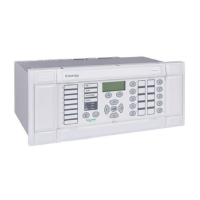Application Notes P54x/EN AP/La4
MiCOM P543, P544, P545 & P546
(AP) 6-9
AP
2. APPLICATION OF INDIVIDUAL PROTECTION FUNCTIONS
The following sections detail the individual protection functions in addition to where and how
they may be applied. Worked examples are provided, to show how the settings are applied
to the relay.
2.1 Differential protection
2.1.1 Setting of the phase differential characteristic
The characte
ristic is determined by four protection settings. All of them are user adjustable.
This flexibility in settings allows the relay characteristic to be tailored to suit particular
sensitivity and CT requirements. To simplify the protection engineer’s task, we strongly
recommend three of the settings be fixed to:
s2 = 2.0 pu
k1 = 30% Provides stability for small CT mismatches, whilst ensuring good sensitivity to
resistive faults under heavy load conditions
k2 = 150% (2 terminal applications) or 100% (3 terminal applications). Provides stability
under heavy through fault current conditions
These settings will give a relay characteristic suitable for most applications leaving only Is1
setting to be decided by the user.
s1 This is the basic differential current setting which determines the minimum pick-up
level of the relay. The value of this setting should be in excess of any mismatch
between line ends, if any, and should also account for line charging current, where
necessary.
If voltage inputs are connected to the relay, there is a feature to extract the charging current
from the measured current before the differential quantity is calculated. In this case, it is
necessary to enter the line positive sequence susceptance value. If capacitive charging
current is enable, s1 may be set below the value of line charging current if required,
however it is suggested that Is1 is chosen only sufficiently below the charging current to offer
the required fault resistance coverage as described here after.
The table below shows some typical steady state charging currents for various lines and
cables.
Voltage (kV)
Core formation
and spacing
Conductor size
in mm
2
Charging current
A/km
11 kV Cable Three-core 120 1.2
33 kV Cable Three-core 120 1.8
33 kV Cable Close-trefoil 300 2.5
66 kV Cable Flat, 127 mm 630 10
132 kV Overhead Line 175 0.22
132 kV Overhead Line 400 0.44
132 kV Cable Three-core 500 10
132 kV Cable Flat, 520 mm 600 20
275 kV Overhead Line 2 x 175 0.58
275 kV Overhead Line 2 x 400 0.58
275 kV Cable Flat, 205 mm 1150 19
275 kV Cable Flat, 260 mm 2000 24
400 kV Overhead Line 2 x 400 0.85
400 kV Overhead Line 4 x 400 0.98

